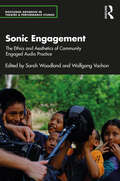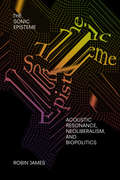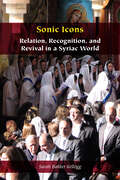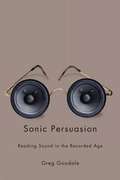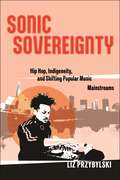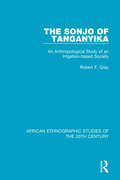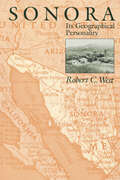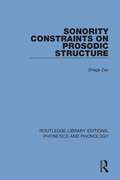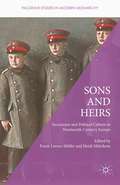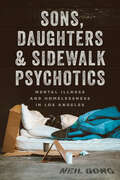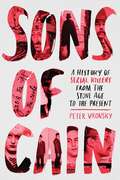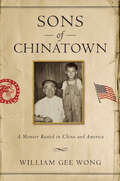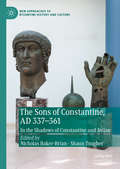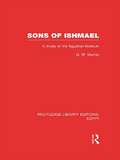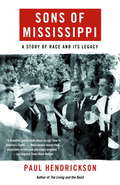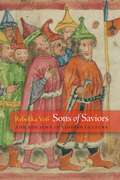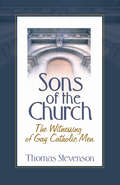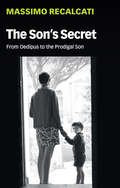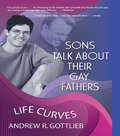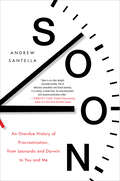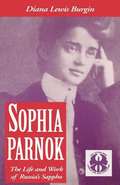- Table View
- List View
Sonic Engagement: The Ethics and Aesthetics of Community Engaged Audio Practice (Routledge Advances in Theatre & Performance Studies)
by Sarah Woodland Wolfgang VachonSonic Engagement examines the relationship between community engaged participatory arts and the cultural turn towards audio, sound, and listening that has been referred to as the 'sonic turn'. This edited collection investigates the use of sound and audio production in community engaged participatory arts practice and research. The popularity of podcast and audio drama, combined with the accessibility and portability of affordable field recording and home studio equipment, makes audio a compelling mode of participatory creative practice. This book maps existing projects occurring globally through a series of case study chapters that exemplify community engaged creative audio practice. The studies focus on audio and sound-based arts practices that are undertaken by artists and arts-led researchers in collaboration with (and from within) communities and groups. These practices include—applied audio drama, community engaged podcasting, sound and verbatim theatre, participatory sound art, community-led acoustic ecology, sound and media walks, digital storytelling, oral history and reminiscence, and radio drama in health and community development. The contributors interrogate the practical, political, and aesthetic potentialities of using sound and audio in community engaged arts practice, as well as its tensions and possibilities as an arts-led participatory research methodology. This book provides the first extensive analysis of what sound and audio brings to participatory, interdisciplinary, arts-led approaches, representing a vital resource for community arts, performance practice, and research in the digital age.
The Sonic Episteme: Acoustic Resonance, Neoliberalism, and Biopolitics
by Robin JamesIn The Sonic Episteme Robin James examines how twenty-first-century conceptions of sound as acoustic resonance shape notions of the social world, personhood, and materiality in ways that support white supremacist capitalist patriarchy. Drawing on fields ranging from philosophy and sound studies to black feminist studies and musicology, James shows how what she calls the sonic episteme—a set of sound-based rules that qualitatively structure social practices in much the same way that neoliberalism uses statistics—employs a politics of exception to maintain hegemonic neoliberal and biopolitical projects. Where James sees the normcore averageness of Taylor Swift and Spandau Ballet as contributing to the sonic episteme's marginalization of nonnormative conceptions of gender, race, and personhood, the black feminist political ontologies she identifies in Beyoncé's and Rihanna's music challenge such marginalization. In using sound to theorize political ontology, subjectivity, and power, James argues for the further articulation of sonic practices that avoid contributing to the systemic relations of domination that biopolitical neoliberalism creates and polices.
Sonic Icons: Relation, Recognition, and Revival in a Syriac World (Orthodox Christianity and Contemporary Thought)
by Sarah Bakker KelloggA vivid, artfully crafted, and deeply hopeful account of one community’s struggle to rediscover and reinvent itself after a century of genocidal loss, dispossession, and displacementTo the extent that Middle Eastern Christians register in Euro-American political imaginaries, they are usually invoked to justify Western military intervention into countries like Iraq or Syria, or as an exemption to anti-Islamic immigration policies because of an assumption that their Christianity makes them easily assimilable in the so-called “Judeo-Christian” West.Using the tools of multisensory ethnography, Sonic Icons uncovers how these views work against the very communities they are meant to benefit. Through long term fieldwork in the Netherlands among Syriac Orthodox Christians—also known as Assyrians, Aramaeans, and Syriacs—Bakker Kellogg reveals how they intertwine religious practice with political activism to save Syriac Christianity from the twin threats of political violence in the Middle East and cultural assimilation in Europe.In a historical moment when much of their tradition has been forgotten or destroyed, their story of self-discovery is one of survival and reinvention. By reviving the late antique Syriac liturgical tradition known as the Daughters and Sons of the Covenant, they seek a complex form of recognition for what they understand to be the ethical core of Christian kinship in an ethnic as well as in a religious sense, despite living in societies that do not recognize this unhyphenated form of ethnoreligiosity as a politically legitimate mode of public identity. Drawing on both theological and linguistic understandings of the icon, Sonic Icons rethinks foundational theoretical accounts of ethnicization, racialization, and secularization by examining how kinship gets made, claimed, and named in the global politics of minority recognition. The icon, as a site of communicative and reproductive power, illuminates how these processes are shaped by religious histories of struggle for sovereignty over the reproductive future.
Sonic Persuasion: Reading Sound in the Recorded Age
by Greg GoodaleSonic Persuasion: Reading Sound in the Recorded Age critically analyzes a range of sounds on vocal and musical recordings, on the radio, in film, and in cartoons to show how sounds are used to persuade in subtle ways. Greg Goodale explains how and to what effect sounds can be "read" like an aural text, demonstrating this method by examining important audio cues such as dialect, pausing, and accent in presidential recordings at the turn of the twentieth century. Goodale also shows how clocks, locomotives, and machinery are utilized in film and literature to represent frustration and anxiety about modernity, and how race and other forms of identity came to be represented by sound during the interwar period. In highlighting common sounds of industry and war in popular media, Sonic Persuasion also demonstrates how programming producers and governmental agencies employed sound to evoke a sense of fear in listeners. Goodale provides important links to other senses, especially the visual, to give fuller meaning to interpretations of identity, culture, and history in sound.
Sonic Sovereignty: Hip Hop, Indigeneity, and Shifting Popular Music Mainstreams (Postmillennial Pop)
by Liz PrzybylskiHonorable Mention, 2024 Alan Merriam Prize, given by the Society for EthnomusicologyWhat does sovereignty sound like?Sonic Sovereignty considers how contemporary Indigenous musicians champion self-determination through musical expression in Canada and the United States. The framework of “sonic sovereignty” connects self-definition, collective determination, and Indigenous land rematriation to the immediate and long-lasting effects of expressive culture. Liz Przybylski covers online and offline media spaces, following musicians and producers as they, and their music, circulate across broadcast and online networks. Przybylski documents and reflects on shifts in both the music industry and political landscape over the course of a decade: as the ways in which people listen to, consume, and interact with popular music have radically changed, extensive public conversations have flourished around contemporary Indigenous culture, settler responsibility, Indigenous leadership, and decolonial futures.Sonic Sovereignty encourages us to experiment with temporal possibilities of listening by detailing moments when a sample, lyric, or musical reference moves a listener out of normative time. Nonlinear storytelling practices from hip hop music and other North American Indigenous sonic practices inform these generative listenings. The musical readings presented in this book thus explore how musicians use tools to help listeners embrace rupture, and how out-of-time listening creates decolonial possibilities.
The Sonjo of Tanganyika: An Anthropological Study of an Irrigation-based Society
by Robert F. GrayOriginally published in 1963, this was the first monograph concerning an African people in which an irrigation-based society was studied in detail and its implications explored. The Sonjo, a Bantu-speaking people isolated among cattle pastoralists of what was Northern Tanganyika, are remarkable for their complex irrigation system and political organization. The inter-connections between the irrigation system, the religious cult of a culture hero, and the special features of their social organization are at the core of this analysis.
Sonora: Its Geographical Personality
by Robert C. WestThis cultural and historical geography of Sonora explores the region&’s dual personality—with modern life existing alongside its colonial past.A land where some streams ran with gold. A landscape nearly empty of inhabitants in the wake of Apache raids from the north. And a former desert transformed by irrigation into vast fields of wheat and cotton. This was and is the state of Sonora in northwest Mexico.Robert C. West explores the dual geographic "personality" of this part of Mexico's northern frontier. Utilizing the idea of "old" and "new" landscapes, he describes two Sonoras—to the east, a semiarid to subhumid mountainous region that reached its peak of development in the colonial era; and, to the west, a desert region that has become a major agricultural producer and the modern center of economic and cultural activity. After a description of the physical and biotic aspects of Sonora, West describes the aboriginal farming cultures that inhabited eastern Sonora before the Spanish conquest. He then traces the spread of Jesuit missions and Spanish mining and ranching communities. He charts the decline of eastern Sonora with the coming of Apache and Seri raids during the eighteenth and nineteenth centuries. And he shows how western Sonora became one of Mexico's most powerful political and economic entities in the twentieth century.
Sonora: Its Geographical Personality
by Robert C. WestThis cultural and historical geography of Sonora explores the region&’s dual personality—with modern life existing alongside its colonial past.A land where some streams ran with gold. A landscape nearly empty of inhabitants in the wake of Apache raids from the north. And a former desert transformed by irrigation into vast fields of wheat and cotton. This was and is the state of Sonora in northwest Mexico.Robert C. West explores the dual geographic "personality" of this part of Mexico's northern frontier. Utilizing the idea of "old" and "new" landscapes, he describes two Sonoras—to the east, a semiarid to subhumid mountainous region that reached its peak of development in the colonial era; and, to the west, a desert region that has become a major agricultural producer and the modern center of economic and cultural activity. After a description of the physical and biotic aspects of Sonora, West describes the aboriginal farming cultures that inhabited eastern Sonora before the Spanish conquest. He then traces the spread of Jesuit missions and Spanish mining and ranching communities. He charts the decline of eastern Sonora with the coming of Apache and Seri raids during the eighteenth and nineteenth centuries. And he shows how western Sonora became one of Mexico's most powerful political and economic entities in the twentieth century.
Sonority Constraints on Prosodic Structure (Routledge Library Editions: Phonetics and Phonology #23)
by Draga ZecFirst published in 1994. The goal of this study is to find the correlations between the internal constituency of the syllable and the sonority of segments. Its major claim is that valid correlations can be established only under the moraic theory of syllable-internal structure. This work thus represents an argument for the moraic theory of the syllable. This title will be of interest to students of language and linguistics.
Sons and Heirs: Succession and Political Culture in Nineteenth-Century Europe (Palgrave Studies in Modern Monarchy)
by Frank Lorenz Müller Heidi MehrkensBringing together an international team of specialists, this volume considers the place of royal heirs within their families, their education and accommodation, their ability to overcome succession crises, the consequences of the death of an heir and finally the roles royal heirs played during the First World War.
Sons, Daughters, and Sidewalk Psychotics: Mental Illness and Homelessness in Los Angeles
by Neil GongSociologist Neil Gong explains why mental health treatment in Los Angeles rarely succeeds, for the rich, the poor, and everyone in between. In 2022, Los Angeles became the US county with the largest population of unhoused people, drawing a stark contrast with the wealth on display in its opulent neighborhoods. In Sons, Daughters, and Sidewalk Psychotics, sociologist Neil Gong traces the divide between the haves and have-nots in the psychiatric treatment systems that shape the life trajectories of people living with serious mental illness. In the decades since the United States closed its mental hospitals in favor of non-institutional treatment, two drastically different forms of community psychiatric services have developed: public safety-net clinics focused on keeping patients housed and out of jail, and elite private care trying to push clients toward respectable futures. In Downtown Los Angeles, many people in psychiatric crisis only receive help after experiencing homelessness or arrests. Public providers engage in guerrilla social work to secure them housing and safety, but these programs are rarely able to deliver true rehabilitation for psychological distress and addiction. Patients are free to refuse treatment or use illegal drugs—so long as they do so away from public view. Across town in West LA or Malibu, wealthy people diagnosed with serious mental illness attend luxurious treatment centers. Programs may offer yoga and organic meals alongside personalized therapeutic treatments, but patients can feel trapped, as their families pay exorbitantly to surveil and “fix” them. Meanwhile, middle-class families—stymied by private insurers, unable to afford elite providers, and yet not poor enough to qualify for social services—struggle to find care at all. Gong’s findings raise uncomfortable questions about urban policy, family dynamics, and what it means to respect individual freedom. His comparative approach reminds us that every “sidewalk psychotic” is also a beloved relative and that the kinds of policies we support likely depend on whether we see those with mental illness as a public social problem or as somebody’s kin. At a time when many voters merely want streets cleared of “problem people,” Gong’s book helps us imagine a fundamentally different psychiatric system—one that will meet the needs of patients, families, and society at large.
Sons of Cain: A History of Serial Killers from the Stone Age to the Present
by Peter VronskyFrom the author of Serial Killers: The Method and Madness of Monsters comes an in-depth examination of sexual serial killers throughout human history, how they evolved, and why we are drawn to their horrifying crimes.Before the term was coined in 1981, there were no "serial killers." There were only "monsters"--killers society first understood as werewolves, vampires, ghouls and witches or, later, Hitchcockian psychos.In Sons of Cain--a book that fills the gap between dry academic studies and sensationalized true crime--investigative historian Peter Vronsky examines our understanding of serial killing from its prehistoric anthropological evolutionary dimensions in the pre-civilization era (c. 15,000 BC) to today. Delving further back into human history and deeper into the human psyche than Serial Killers--Vronsky's 2004 book, which has been called the definitive history of serial murder--he focuses strictly on sexual serial killers: thrill killers who engage in murder, rape, torture, cannibalism and necrophilia, as opposed to for-profit serial killers, including hit men, or "political" serial killers, like terrorists or genocidal murderers.These sexual serial killers differ from all other serial killers in their motives and their foundations. They are uniquely human and--as popular culture has demonstrated--uniquely fascinating.
Sons of Chinatown: A Memoir Rooted in China and America
by William Gee WongWilliam Gee Wong was born in Oakland, California’s Chinatown in 1941, the only son of his father, known as Pop. Pop was born in Guangdong Province, China and emigrated to Oakland as a teenager during the Chinese Exclusion era in 1912. He entered the U.S. legally as the “son of a native,” despite having partially false papers. Sons of Chinatown is Wong’s evocative dual memoir of his and his father’s parallel experiences in America. As Pop grappled with the systemic racism towards Asians during the exclusion era, Wong wistfully depicts Pop’s efforts to establish a family business and build a life for his family in segregated Oakland. As the exclusion law ended in 1943, young William was assimilating into American life and developing his path as a journalist. Writing for the Wall Street Journal, Oakland Tribune, and Asian American periodicals, Wong chronicled Asian American experiences while honoring Chinese American history and identity, but he too faced discrimination. Sons of Chinatown poignantly weaves these father and son stories together with admiration and righteous anger. Through the mirrored lens of his father, Wong reflects on the hardships Asian Americans endured—and continue to face—with American exceptionalism. Wong’s inspiring memoir provides a personal history that also raises the question of whether America welcomes or repels immigrants.
The Sons of Constantine, AD 337-361: In the Shadows of Constantine and Julian (New Approaches to Byzantine History and Culture)
by Nicholas Baker-Brian Shaun TougherThis edited collection focuses on the Roman empire during the period from AD 337 to 361. During this period the empire was ruled by three brothers: Constantine II (337-340), Constans I (337-350) and Constantius II (337-361). These emperors tend to be cast into shadow by their famous father Constantine, the first Christian Roman emperor (306-337), and their famous cousin Julian, the last pagan Roman emperor (361-363). The traditional concentration on the historically renowned figures of Constantine and Julian is understandable but comes at a significant price: the neglect of the period between the death of Constantine and the reign of Julian and of the rulers who governed the empire in this period. The reigns of the sons of Constantine, especially that of the longest-lived Constantius II, mark a moment of great historical significance. As the heirs of Constantine they became the guardians of his legacy, and they oversaw the nature of the world in which Julian was to grow up. The thirteen contributors to this volume assess their influence on imperial, administrative, cultural, and religious facets of the empire in the fourth century.
Sons of Ishmael: A Study of the Egyptian Bedouin (Routledge Library Editions: Egypt)
by G.W. MurrayMerely to inhabit a desert demands much skill, craft, experience and travel. For the numerous nomadic tribes of Africa and the Middle East, living ancestors of the Egyptians, Jews and Arabs, Egypt is their meeting ground. The author, with twenty-five years of accumulated knowledge, here sets out to present analyses of their cultures and beliefs, along with descriptions of each tribe. First published 1935.
Sons of Mississippi
by Paul HendricksonThey stand as unselfconscious as if the photograph were being taken at a church picnic and not during one of the pitched battles of the civil rights struggle. None of them knows that the image will appear in Life magazine or that it will become an icon of its era. The year is 1962, and these seven white Mississippi lawmen have gathered to stop James Meredith from integrating the University of Mississippi. One of them is swinging a billy club. More than thirty years later, award-winning journalist and author Paul Hendrickson sets out to discover who these men were, what happened to them after the photograph was taken, and how racist attitudes shaped the way they lived their lives. But his ultimate focus is on their children and grandchildren, and how the prejudice bequeathed by the fathers was transformed, or remained untouched, in the sons. Sons of Mississippi is a scalding yet redemptive work of social history, a book of eloquence and subtlely that tracks the movement of racism across three generations and bears witness to its ravages among both black and white Americans.
Sons of Mississippi: A Story of Race and its Legacy
by Paul HendricksonThe true story of a racial murder in the South.
The Sons of Molly Maguire: The Irish Roots of America's First Labor War
by Mark BulikSensational tales of true-life crime, the devastation of the Irish potato famine, the upheaval of the Civil War, and the turbulent emergence of the American labor movement are connected in a captivating exploration of the roots of the Molly Maguires. A secret society of peasant assassins in Ireland that re-emerged in Pennsylvania’s hard-coal region, the Mollies organized strikes, murdered mine bosses, and fought the Civil War draft. Their shadowy twelve-year duel with all powerful coal companies marked the beginning of class warfare in America. But little has been written about the origins of this struggle and the folk culture that informed everything about the Mollies.A rare book about the birth of the secret society, The Sons of Molly Maguire delves into the lost world of peasant Ireland to uncover the astonishing links between the folk justice of the Mollies and the folk drama of the Mummers, who performed a holiday play that always ended in a mock killing. The link not only explains much about Ireland’s Molly Maguires—where the name came from, why the killers wore women’s clothing, why they struck around holidays—but also sheds new light on the Mollies’ re-emergence in Pennsylvania.The book follows the Irish to the anthracite region, which was transformed into another Ulster by ethnic, religious, political, and economic conflicts. It charts the rise there of an Irish secret society and a particularly political form of Mummery just before the Civil War, shows why Molly violence was resurrected amid wartime strikes and conscription, and explores how the cradle of the American Mollies became a bastion of later labor activism. Combining sweeping history with an intensely local focus, The Sons of Molly Maguire is the captivating story of when, where, how, and why the first of America’s labor wars began.
The Sons of Remus: Identity in Roman Gaul and Spain
by Andrew C. JohnstonHistories of Rome emphasize the ways the empire assimilated conquered societies, bringing civilization to “barbarians.” Yet these interpretations leave us with an incomplete understanding of the diverse cultures that flourished in the provinces. Andrew C. Johnston recaptures the identities, memories, and discourses of these variegated societies.
Sons of Saviors: The Red Jews in Yiddish Culture (Jewish Culture and Contexts)
by Rebekka VoßEnvisioned as a tribe of ruddy-faced, redheaded, red-bearded Jewish warriors, bedecked in red attire who purportedly resided in isolation at the fringes of the known world, the Red Jews are a legendary people who populated a shared Jewish-Christian imagination. But in fact the red variant of the Ten Lost Tribes of Israel is a singular invention of late medieval vernacular culture in Germany. This idiosyncratic figure, together with the peculiar term “Red Jews,” existed solely in German and Yiddish, the German-Jewish vernacular. These two language communities assessed the Red Jews differently and contested their significance, which is to say, they viewed them in different shades of red. The voyage of the Red Jews through the Jewish and Christian imagination, from their medieval Christian nascence, through early modern Old Yiddish literature, to modern Yiddish culture in Eastern Europe, Palestine, and America, is the story of this book.By studying this vernacular icon, Rebekka Voß contributes to our understanding of the formation of minority awareness and the construction of Ashkenazic Jewish identity through visual cultural encounters. She also spotlights the vitality of vernacular culture by demonstrating how the premodern motif of the Red Jews informed modern Yiddish literature, and how the stereotype of Jewish red hair found its way into Jewish social critiques, political thought, and arts through the present day.Sons of Saviors is a story about power: the Yiddish reappropriation of the Red Jews subverted the Christian color symbolism by adjusting the focus on redness from a negative stereotype into a proud badge of self-assertion. The book also includes in an appendix the full text of a significant Yiddish tale featuring the Red Jews.
Sons of the Church: The Witnessing of Gay Catholic Men
by Thomas B StevensonThe book that can help you reconcile being both gay and CatholicSons of the Church: The Witnessing of Gay Catholic Men spotlights testimonials from over thirty gay Catholic men to answer the question, "How can you be gay and Catholic?" Dr. Thomas B. Stevenson, who received degrees from the University of Notre Dame, Boston College, and the Graduate Theological Union in Berkeley, explores this question, using various interviews to thoroughly analyze the many dimensions of being gay and Catholic while providing a powerful and convincing criticism of Church teaching on homosexuality. This thoughtful, surprisingly reverent book is the answer for those gay readers who long for a religious connection, as well as for Catholic readers and those in pastoral positions who want and need to hear the stories of gay people firsthand. Sons of the Church: The Witnessing of Gay Catholic Men tells one story-the story of what it is like to be gay and Catholic-through the various stories of over thirty gay Catholic men. Each chapter is arranged thematically, beginning with experiences of being homosexual and Catholic during childhood and youth. Subsequent chapters delve into the ways these men each finally accepted themselves and integrated their sexuality, related to others who did or did not understand, dealt with homosexual promiscuity, found intimate relationships, became a part of a community, and ultimately came to terms with the Catholic Church and their faith. Throughout, these &’witnesses&’ explain how their faith in God guides them through the various experiences and issues they face. The positive aspects of Catholic Christianity are respectfully explored at the same time as the present Church teaching on homosexuality is challenged.Sons of the Church uses interviews to explore: Catholics coming to terms with their homosexuality the experiences of young men recognizing their sexuality suffering and oppression by society and the Church acceptance of self integration of goodness and lovability of homosexuality moral issues of promiscuity among gay men gay relationships and the Catholic dimensions of commitment criticisms of gay culture the Catholic Church teachings on homosexuality the answer to the question, "How can you be gay and Catholic?"Sons of the Church: The Witnessing of Gay Catholic Men is enlightening reading essential for educators, students, counselors, priests, nuns, psychologists, and theologians. Catholic people, gay people, and every educated reader will find that the interviews and ideas here stimulate thought and create a greater understanding of the issue of homosexuality and faith.
The Son's Secret: From Oedipus to the Prodigal Son
by Massimo RecalcatiThis new book by Massimo Recalcati focuses on the psycho-social life of the son. Comparing and contrasting the tragic story of Oedipus by Sophocles and the parable of the prodigal son, Recalcati argues that all common parenting strategies, whether authoritarian or democratic, are attempts at sealing the fate of sons – that is, they are designed to ensure that sons realize the dreams and fantasies of the parents. But all that sons want – and this is their secret because they generally do not want, or are unable, to confront their parents directly – is to be recognized as unique, as different, as independent, free-thinking individuals who are able to chart their own path in life, rather than extensions of their parents' fantasies. The parents' task is to acknowledge this, and to create the space for this desire to flourish. Continuing his remarkable reflections on parents, children and family life, this new book by one of Italy's leading and bestselling public intellectuals will be of interest to a wide general readership.
Sons Talk About Their Gay Fathers: Life Curves
by Andrew GottliebExamine the impact of disclosure on sons whose fathers are gay! In this book, Andrew Gottlieb, author of Out of the Twilight: Fathers of Gay Men Speak, explores yet another side of the impact of homosexuality on families. He now looks at how sons react to learning that their fathers are gay, allowing us to see, over time, how this has changed their family relationships and their own lives. Simply and elegantly written, this psychoanalytically oriented qualitative research study is accessible to both the beginner and the more advanced researcher and practitioner. It draws from a wide range of literary, popular, and psychological sources and includes an interview guide, a reference section, and an index. "When someone discloses as gay, lesbian, or bisexual, it is not just an individual event. It is a family event. Based on estimates of married gay, lesbian, and bisexual persons, a spouse's coming out affects up to 2,000,000 couples. Yet, its impact has been largely ignored. Children&’s voices are the least often heard. . . . Little has been written about sons of fathers who came out during or after marriage. Data for studies that do exist most often draw from the fathers' point of view. . . . The significance of this study lies in its comprehensive, detailed picture of sons and gay fathers as they develop their separate self-images as well as the images of their son-father relationships over time. Painful, sensitive, often triumphant, the stories and [the author&’s] analysis of their thoughts, perceptions, and feelings afford a multidimensional, longitudinal viewing. Step by step, we follow the complicated dance of these sons and fathers as they develop and define their connection." -from the Foreword by Amity Pierce Buxton, Author of The Other Side of the Closet: The Coming-Out Crisis for Straight Spouses and Families Sons Talk About Their Gay Fathers: Life Curves is a storybook-an extended narrative moved along, but not overshadowed, by psychoanalytic theory. The Introduction briefly reviews more recent writings of the fathering experience as told by gay men themselves, setting the stage for: "Father to Child"-a look at the father as seen through the ever-shifting eyes of his son at different phases of the life cycle "The Quest for the Real Father"-an examination of sons' responses to their fathers' homosexuality as captured in film, fiction, nonfiction, television, and the psychological literature "Methodology"-the story of the research process, including sampling, the search for subjects, trustworthiness, the interview, bias, and data collection "The Stories"-an anthology of narratives the author constructed from the interview material, painting an intimate portrait of each individual son "Findings"-a categorical analysis "Discussion"-a summary of all the preceding material cast in a developmental framework, highlighting implications for future research and clinical practice
Soon: An Overdue History of Procrastination, from Leonardo and Darwin to You and Me
by Andrew Santella“Casually erudite, full of delicious anecdotes and brutal honesty, it is catnip, in book form, for procrastinators and non-procrastinators alike.” —Jennifer Egan, Pulitzer Prize–winning authorLike so many of us, including most of America’s workforce, and nearly two-thirds of all university students, Andrew Santella procrastinates. Concerned about his habit, but not quite ready to give it up, he set out to learn all he could about the human tendency to delay. He studied history’s greatest procrastinators to gain insights into human behavior, and also, he writes, to kill time, “research being the best way to avoid real work.”He talked with psychologists, philosophers, and priests. He visited New Orleans’ French Quarter, home to a shrine to the patron saint of procrastinators. And at the home of Charles Darwin outside London, he learned why the great naturalist delayed writing his masterwork for more than two decades.Drawing on an eclectic mix of historical case studies in procrastination—from Leonardo da Vinci to Frank Lloyd Wright, and from Old Testament prophets to Civil War generals—Santella offers a sympathetic take on habitual postponement. He questions our devotion to “the cult of efficiency” and suggests that delay and deferral can help us understand what truly matters to us. Being attentive to our procrastination, Santella writes, means asking, “whether the things the world wants us to do are really worth doing.” “Well-researched . . . [Soon] argues that in many cases eminent figures have done great work while putting off work they were supposed to be doing. Procrastination might, for some people, be part of innovation and the creative process.” —The Wall Street Journal
Sophia Parnok: The Life and Work of Russia's Sappho
by Diana L. Burgin"The weather in Moscow is good, there's no cholera, there's also no lesbian love... Brrr! Remembering those persons of whom you write me makes me nauseous as if I'd eaten a rotten sardine. Moscow doesn't have them--and that's marvellous." Anton Chekhov, writing to his publisher in 1895. Chekhov's barbed comment suggests the climate in which Sophia Parnok was writing, and is an added testament to to the strength and confidence with which she pursued both her personal and artistic life. Author of five volumes of poetry, and lover of Marina Tsvetaeva, Sophia Parnok was the only openly lesbian voice in Russian poetry during the Silver Age of Russian letters. Despite her unique contribution to modern Russian lyricism however, Parnok's life and work have essentially been forgotten. Parnok was not a political activist, and she had no engagement with the feminism vogueish in young Russian intellectual circles. From a young age, however, she deplored all forms of male posturing and condescension and felt alienated from what she called patriarchal virtues. Parnok's approach to her sexuality was equally forthright. Accepting lesbianism as her natural disposition, Parnok acknowledged her relationships with women, both sexual and non-sexual, to be the centre of her creative existence. Diana Burgin's extensively researched life of Parnok is deliberately woven around the poet's own account, visible in her writings. The book is divided into seven chapters, which reflect seven natural divisions in Parnok's life. This lends Burgin's work a particular poetic resonance, owing to its structural affinity with one of Parnok's last and greatest poetic achievements, the cycle of love lyrics Ursa Major. Dedicated to her last lover, Parnok refers to this cycle as a seven-star of verses, after the seven stars that make up the constellation. Parnok's poems, translated here for the first time in English, added to a wealth of biographical material, make this book a fascinating and lyrical account of an important Russian poet. Burgin's work is essential reading for students of Russian literature, lesbian history and women's studies.
